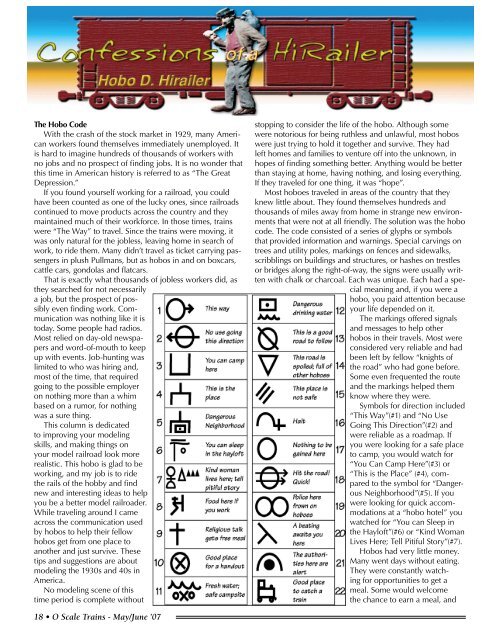You also want an ePaper? Increase the reach of your titles
YUMPU automatically turns print PDFs into web optimized ePapers that Google loves.
The Hobo CodeWith the crash of the stock market in 1929, many Americanworkers found themselves immediately unemployed. Itis hard to imagine hundreds of thousands of workers withno jobs and no prospect of finding jobs. It is no wonder thatthis time in American history is referred to as “The GreatDepression.”If you found yourself working for a railroad, you couldhave been counted as one of the lucky ones, since railroadscontinued to move products across the country and theymaintained much of their workforce. In those times, trainswere “The Way” to travel. Since the trains were moving, itwas only natural for the jobless, leaving home in search ofwork, to ride them. Many didn’t travel as ticket carrying passengersin plush Pullmans, but as hobos in and on boxcars,cattle cars, gondolas and flatcars.That is exactly what thousands of jobless workers did, asthey searched for not necessarilya job, but the prospect of possiblyeven finding work. Communicationwas nothing like it istoday. Some people had radios.Most relied on day-old newspapersand word-of-mouth to keepup with events. Job-hunting waslimited to who was hiring and,most of the time, that requiredgoing to the possible employeron nothing more than a whimbased on a rumor, for nothingwas a sure thing.This column is dedicatedto improving your modelingskills, and making things onyour model railroad look morerealistic. This hobo is glad to beworking, and my job is to ridethe rails of the hobby and findnew and interesting ideas to helpyou be a better model railroader.While traveling around I cameacross the communication usedby hobos to help their fellowhobos get from one place toanother and just survive. Thesetips and suggestions are aboutmodeling the 1930s and 40s inAmerica.No modeling scene of thistime period is complete withoutstopping to consider the life of the hobo. Although somewere notorious for being ruthless and unlawful, most hoboswere just trying to hold it together and survive. They hadleft homes and families to venture off into the unknown, inhopes of finding something better. Anything would be betterthan staying at home, having nothing, and losing everything.If they traveled for one thing, it was “hope”.Most hoboes traveled in areas of the country that theyknew little about. They found themselves hundreds andthousands of miles away from home in strange new environmentsthat were not at all friendly. The solution was the hobocode. The code consisted of a series of glyphs or symbolsthat provided information and warnings. Special carvings ontrees and utility poles, markings on fences and sidewalks,scribblings on buildings and structures, or hashes on trestlesor bridges along the right-of-way, the signs were usually writtenwith chalk or charcoal. Each was unique. Each had a specialmeaning and, if you were ahobo, you paid attention becauseyour life depended on it.The markings offered signalsand messages to help otherhobos in their travels. Most wereconsidered very reliable and hadbeen left by fellow “knights ofthe road” who had gone before.Some even frequented the routeand the markings helped themknow where they were.Symbols for direction included“This Way”(#1) and “No UseGoing This Direction”(#2) andwere reliable as a roadmap. Ifyou were looking for a safe placeto camp, you would watch for“You Can Camp Here”(#3) or“This is the Place” (#4), comparedto the symbol for “DangerousNeighborhood”(#5). If youwere looking for quick accommodationsat a “hobo hotel” youwatched for “You can Sleep inthe Hayloft”(#6) or “Kind WomanLives Here; Tell Pitiful Story”(#7).Hobos had very little money.Many went days without eating.They were constantly watchingfor opportunities to get ameal. Some would welcomethe chance to earn a meal, and18 • O <strong>Scale</strong> <strong>Trains</strong> - May/June ’07
















